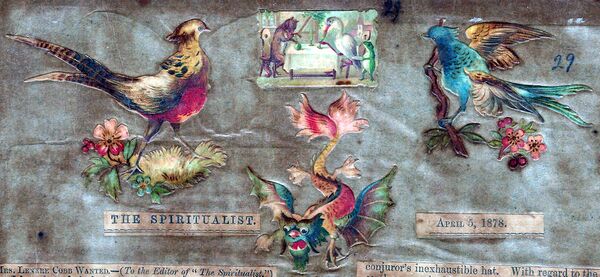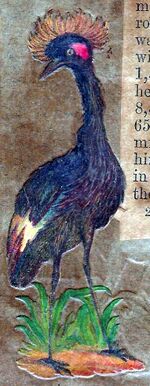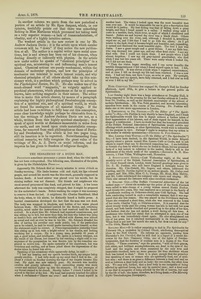
Mrs. Lenere Cobb Wanted
Mrs. Lenere Cobb Wanted.—(To the Editor of “The Spiritualist.”} Sir,—I have been desired, in the Spiritual World, to make diligent enquiry about a person named Mrs. Lenere Cobb or Coobe, and to ask others to report what can be discovered respecting her. I am forbidden to furnish any data by which she can be found to others, but am promised facts of a test nature in reference to the matter, likely to aid in the settlement of the whole truth of the question.— Kenneth R. H. Mackenzie, 1 Flint Villas, Wellington-road, Hounslow.

<Untitled> (Soulless Men)
Soulless Men.—It is rather surprising to find in The Spiritualist for February 8th, a quotation by Colonel Olcott, attributing theosophical ideas to the New Church. He informs an opponent, quoting from Blavatsky’s Isis Unveiled, that he will find in a report of a recent discourse by the Rev. Chauncey Giles, one of the lights of Sweden-borgianism, that the doctrine of soulless men is a dogma of the New Church. “These creatures,’’ says the preacher, “with all their graces, rich attire, and brilliant accomplishments, are dead in the eyes of the Lord and the angels, and when measured by the only true and immutable standard, have no more genuine life than skeletons whose flesh has turned to dust.’’ Here it is plain enough that the preacher was speaking of men or women who are spiritually dead, not of soulless men; and there is as great a difference between a dead soul and no soul as between a dead body and no body: the one exists, the other does not. We may add, further, that a dead body is one incapable of being affected by spiritual forces, but only by material ones; and a dead soul is one that is incapable of being affected by the life of heaven, but only by the life of hell; the latter, therefore, ii a living death.—The Morning Light (Swedenborgian Newspaper).

Indian Mysticisms
In The Spiritualist of March 22nd, your correspondent, “T. J.,” gives an account of some Indian jugglery, taken from the Oriental Annual. As he asks if any of your readers who have travelled can explain them, I venture to do what I can in that way. I have passed seven years of my life in India, have seen any amount of tricks and feats, and have been greatly disappointed with most of them. Although the natives have great sleight of hand, a practised eye will detect the way in which every trick is done. The mango trick is done by substituting different growths of a mango tree by sleight of hand. Although, as “T. J.” says, the natives generally have “no raiment excepting a small cloth round their loins,” they invariably have a bag with them, which they lay alongside whilst they do their tricks; and if you open this bag before they commence, as I have done, you will find the mango seed, a sprig of mango tree with two leaves on it, another sprig with a lot of leaves, and a still larger one with a young mango. The mode of introducing these under the basket is after the same fashion as the English conjuror’s inexhaustible hat. With regard to the miraculous earthen vessel which appeared full and empty at will, I have not only seen the trick done, but I have a similar vessel now in my possession. I got a juggler—a fadu-wallah—to make me one in copper exactly the same as his earthenware one, and I shall be very happy to send it to you for your correspondent to see. Without casting a doubt on the truth of the description of the trick, as seen by the person quoted, I do not believe that the same vessel—a “chattie,” as it is called—was broken before his eyes, but that a similar one was substituted by sleight of hand, and then broken. I have seen this trick done many times, but have never seen the chattie broken.
The other tricks mentioned I have never seen, but I may say that when a description of a trick is given by a person unacquainted with juggler’s ways, it is found very unlike that which would be given by an adept in the art. “T. J.” says “Here, however, is the difficulty, that there are no confederates concealed behind curtains at the rear of public platforms, with shaded lights and oblique tables, the surface placed just above the line of vision.” That is true enough, but there is a great deal in that little fat bag that they always carry with them, and it requires many rupees before a peep into it is allowed.
A native of Belgaum once told me that, in ancient days, there was a preparation used which, after seeds had been soaked in it, would make them shoot up in a few minutes. He said that this preparation was made by spreading a piece of flannel over the grain plant at night when the moon was full. In the morning the flannel would be found full of moisture. This was pressed out, and the operation con-tinned until a little bottle of this stuff was obtained. Any seed left in this for some days, and then carefully dried, would shoot up at once when planted and watered. He went so far as to get me a bottle of this stuff, and seemed very confident about it. However, we tried it, and did not succeed. He was so vexed about this that, determined to show me something wonderful, he brought up to my bungalow an old man who, he said, could do wonderful feats in mental arithmetic. I put him to the test by giving him rows of figures to multiply together. In every instance he was right. He ultimately offered to play a game of chess with me, and do a sum at the same time; so I gave him 1,345,678 to be multiplied by 6,543,123. In ten minutes he had beaten me and given me the answer, viz., 8,804,936,672,394. I did it myself on paper, and made it 657 instead of 667, so I hoped I had caught him making a mistake, but he was right after all. The next day I asked him if he remembered the figures, and he repeated them off in their right order at once. I wrote all the sums down at the time, and have just copied them out now.
27th March, 1878.


Editor's notes
- ↑ image by unknown author
- ↑ Mrs. Lenere Cobb Wanted by unknown author, London Spiritualist, No. 293, April 5, 1878, p. 159
- ↑ image by unknown author. colored women
- ↑ Soulless Men by unknown author, London Spiritualist, No. 293, April 5, 1878, p. 159
- ↑ image by unknown author
- ↑ Indian Mysticisms by unknown author (signed as E. S. G.), London Spiritualist, No. 293, April 5, 1878, pp. 161-2
- ↑ image by unknown author
- ↑ image by unknown author
Sources
-
London Spiritualist, No. 293, April 5, 1878, p. 159
-
London Spiritualist, No. 293, April 5, 1878, pp. 161-2



